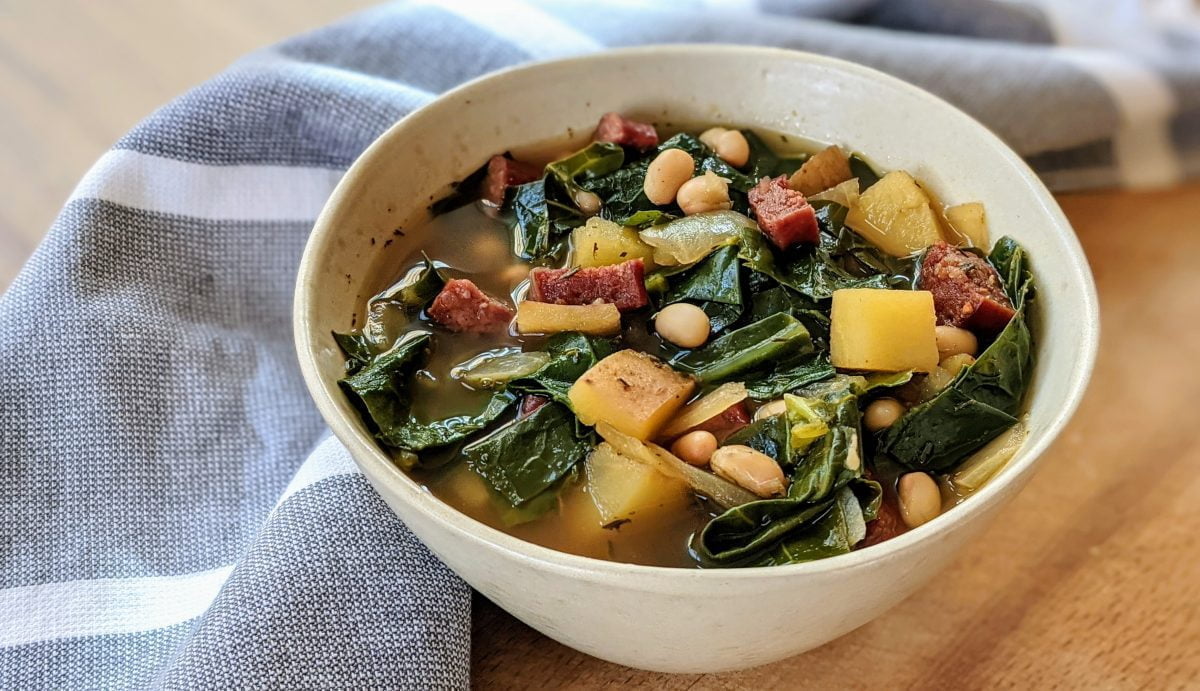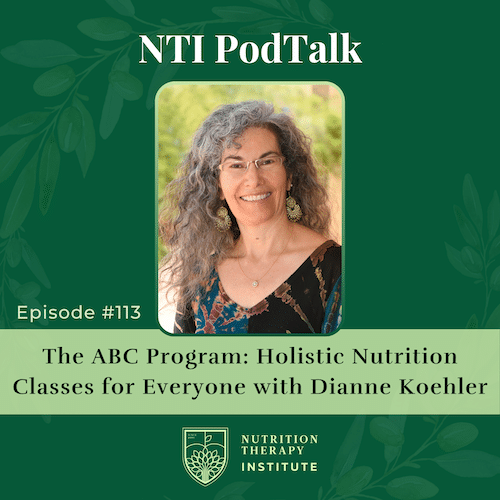
Share this post!
Here’s a recipe for the perfect winter-to-spring transition soup. It’s hearty, but not too heavy. It’s simple, but also flavorful. If you decide to celebrate St. Patrick’s Day with an Irish-inspired meal, this Hearty Kale & Sausage Soup is an easy and nutritious option!
What’s the deal with nitrates?
We often hear that cured meats should be avoided because of their high nitrate/nitrite content which has been associated with carcinogenic effects. Nitrite and nitrate are important food additives in cured meat products that have been used since about 3000 BC. The consumption of nitrates is a controversial topic. It seems that nitrates themselves are harmless, but when they convert to nitrosamines, they could have negative effects. When nitrates enter our mouths, the bacteria in the mouth or the enzymes in the body turn the nitrates into nitrites. Nitrites are beneficial when they form nitric oxide, but when nitrites form a compound called nitrosamine, they can have a negative effect and become carcinogenic.
Nitrate benefits and risks
On one hand, most of the nitrate we consume is through vegetables (about 85%) – vegetables like beets, spinach and arugula are very high in nitrates! The nitrates in these vegetables convert to nitric oxide, leading to numerous health benefits such as better blood pressure control and improved cardiovascular health. You may have heard of athletes consuming beetroot juice as a high source of nitrates to improve athletic performance! On the other hand, consumption of cured meat high in nitrates/nitrites has been linked to increased rates of certain cancers. However, published results of human studies on the relationship between nitrate and nitrite intake and cancer risk remain inconsistent.
A study has suggested a cancer reduction with nitrate consumption, but an increase in cancer rates with nitrite and nitrosamine consumption. The researchers in this study speculate that since the nitrates were provided mainly by vegetables, the health benefits may be more linked to the beneficial effects of other protective compounds (such as antioxidants or vitamins) rather than the nitrates themselves.
Dangers of nitrosamines
As mentioned above, the cancer risks from nitrates/nitrites are due to their potential conversion to a compound called nitrosamine, which has been shown to have carcinogenic effects. How do nitrosamines form?
- When nitrites hit the highly acidic juices in the stomach, nitrites convert to nitrous acid. The nitrous acid reacts with amines (chemicals related to ammonia that are found abundantly in protein foods) to form nitrosamines.
- High temperatures and frying can increase the potential for nitrosamines.
- The presence of heme iron (the iron in meat) increases the production of nitrosamines.
Overall, our goal is to avoid the production of nitrosamines when we consume nitrates, since the nitrosamines are the carcinogenic compounds. One approach could be incorporating sufficient antioxidants into our diets, because the presence of dietary antioxidants inhibits the generation of nitrosamines. There is research on adding plant compounds such as rosemary essential oil, celery juice, fermented spinach powder, etc., to cured meat products. The addition of these antioxidants helps control lipid oxidation and reduces nitrite amounts.
Healthy tips for consuming nitrates
So what does this inconsistent research show us? Can we eat cured meats like sausage and bacon? What about plant-based foods high in nitrates? Here are some guidelines to help you make healthy dietary decisions:
- If you eat meat – whether it’s ground bison or sausages or bacon – make sure to source it from reliable high-quality sources
- Avoid heavily processed, cheap meats that have chemical additives
- Focus on plant-based sources of nitrates (arugula, spinach, lettuce, beets, radish, etc.) that have shown to provide numerous health benefits and are not likely to form cancer-causing nitrosamines
- When consuming cured meats that contain nitrates, any negative health effects can be reduced by preparing the meat at lower temperatures
- Since dietary antioxidants inhibit the production of nitrosamines, it may be a good idea to eat some colorful vegetables and other antioxidant-rich foods along with your sausage or bacon
- Overall, the best practice is to adopt a diet with tons of diversity! Consume many different types of whole foods, prepared in a variety of ways — and go ahead and enjoy a bowl of Hearty Kale & Sausage Soup…
Hearty Kale & Sausage Soup
Ingredients
- 1 tbsp olive oil
- 4 link linguica, chorizo, or other spicy sausage, split along the length and sliced into ½-inch thick
- 1 onion, diced
- 3 small or 2 medium red-skinned potatoes, skin left on and diced
- 3 cloves garlic, minced
- 1 bunch kale or collard greens, stripped of stems and cut into small pieces
- 4-6 cups vegetable broth
- 1 tbsp dried thyme
- 1 tsp dried oregano
- 1 bay leaf
- 1 rind Parmesan or Pecorino cheese (optional)
- 15-oz. can white beans, like navy, cannellini, or Great Northern, drained and rinsed
- Salt and pepper, to taste
Instructions
- Set a large soup pot over medium-high heat and add the oil. When the oil is hot, add the sausage and sauté until the sausage is browned. Remove the sausage, leaving behind any oil, and drain on a paper towel.
- Reduce heat to medium and add the onion. Sauté until the onion is translucent, and then add the diced potatoes. Sauté until the edges of the potatoes are starting to turn transparent, about 5-10min.
- Add the garlic and sauté until fragrant, about 30 seconds.
- Add ½ cup of vegetable broth and the greens to the pot. Stir to coat everything with the vegetable broth and cover the pot with a lid. Stir the mixture every few minutes until it is barely tender, adding more broth if the pot becomes dry. This should take about 10 minutes.
- Add the rest of the broth, thyme, oregano, bay leaf, cheese rind, and salt. Add enough broth to cover the vegetables completely. Bring the soup to a boil over high heat, and then reduce to medium and simmer until the kale is completely tender and the potatoes are cooked through.
- Add the sausage and white beans.
- Remove the bay leaf and cheese rind, if added.
- Taste for seasonings and salt.
Makes 4-6 servings
Recipe adapted from the Kitchn
Want to learn how to create and prepare recipes like this?
Join our Natural Food Chef Program! Picture yourself in your kitchen surrounded by nothing but organic vegetables, whole grains, top-quality meats, eggs and a range of the more unusual things like pâté, kimchi, kefir and bone broth. If you resonate with the idea of creating delicious meals that are not only healthy but downright regenerative, then join us for our 15-week program!
Daina Rasutis is a recent graduate of NTI’s Nutrition Therapist Master Program. She plans to use her certification to spark a craving for health through movement, sustainable living and, of course, nourishing food. Follow Daina’s cooking creations and lifestyle tips on Instagram: @tabletocrave
Image use permission given by Table to Crave
Share this post!




















